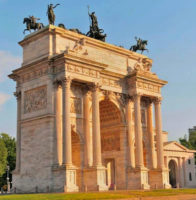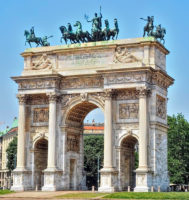Found in the semicircular opening of Piazzale Sempione, this is a regular construction with precise height limits; the Arch of Peace rising in isolation is considered the most representative object of Lombardic neo-classicism.
It was begun in 1807 on plans drawn by Luigi Cagnola to celebrate the Napoleonic victories. It has a strong agile structure notwithstanding its decorative exuoerance.
The archway, the ideal end to the road which Napoleon had planned to use to reach Briga, and from there to open up a speedy passage for his men and arms across the Sempion Pass.
The arch consists of three barrel vaults supported by Corinthian columns on pedistals, with a trabeation and a high attic above which dominates the six bronze horses cast by Abbondio Sangiorgio, and the Winged Victory done by Giovanni Putti. On the trabeation there are the four allegorical figures of the four rivers of the Italian Republic the Po and the Ticino bv Cacciatori and Marchesi’s Tagliamento and Adige. On the walls are accademical bas-reliefs begun by Camilio Pacetti, Pompeo Marchesi and Benedetto Cacciatori; it was finished in the atmosphere of the Austrian restoration by Peverelli and Moglia in 1833.
When Napoleon fell all the figures were made unrecognizable by the addition of Roman togas. The Napoleonic arch become the symbol of the Hapsburgian peace. After the fall of Napoleon the arch was inaugurated on September 10th. 1838 with the coming of Ferdinand II of Austria to Milan to receive the “Iron Crown”.
In 1859 the Arch of Peace celebrated the new national victory and under it, in solemn procesison, passed Napoleon III and Victor Emanuel II on their way into the city after the victory of the battle of Magenta; a historical fact which was repeated, a hundred years later, when to celebrate the centenary of the event, General De Gaulle and Giovanni Gronchi passed under it.





















